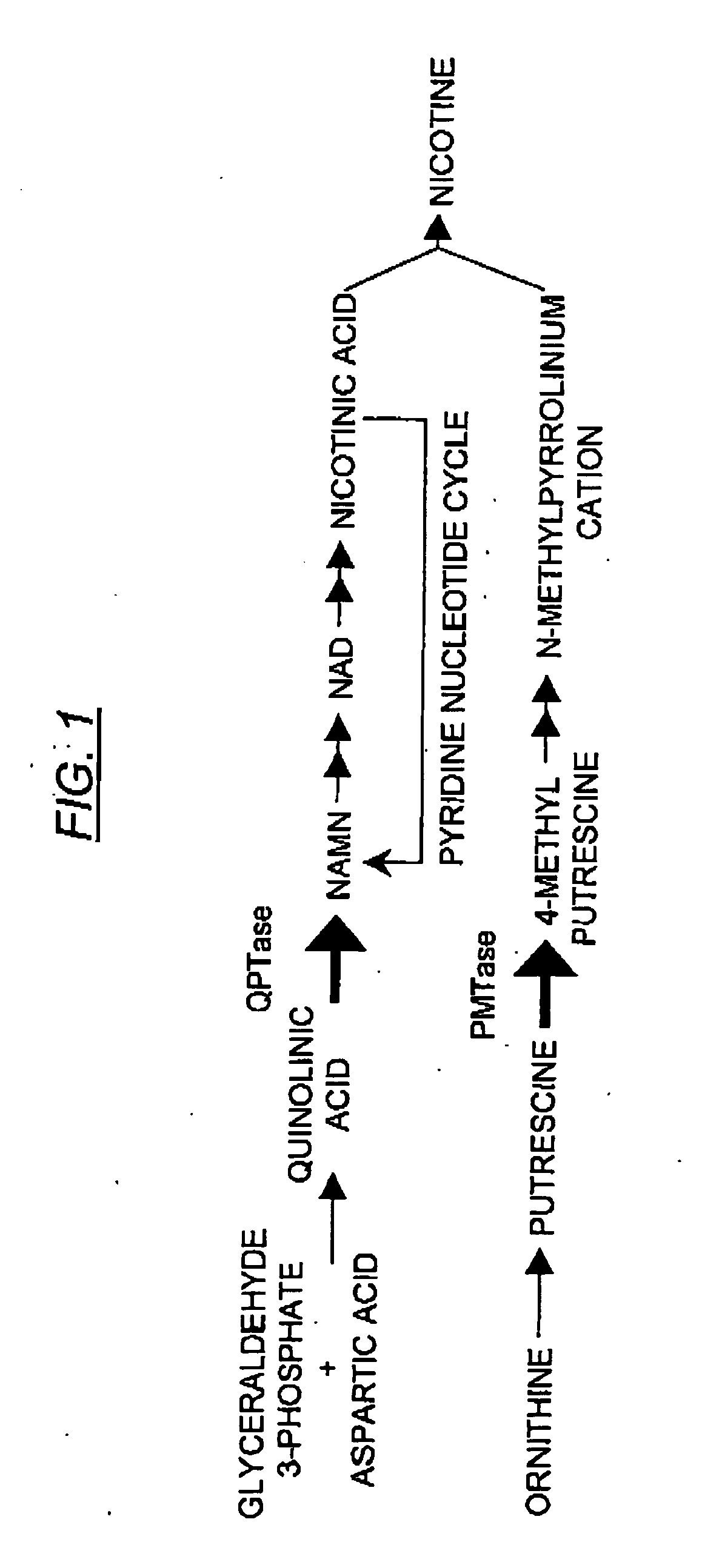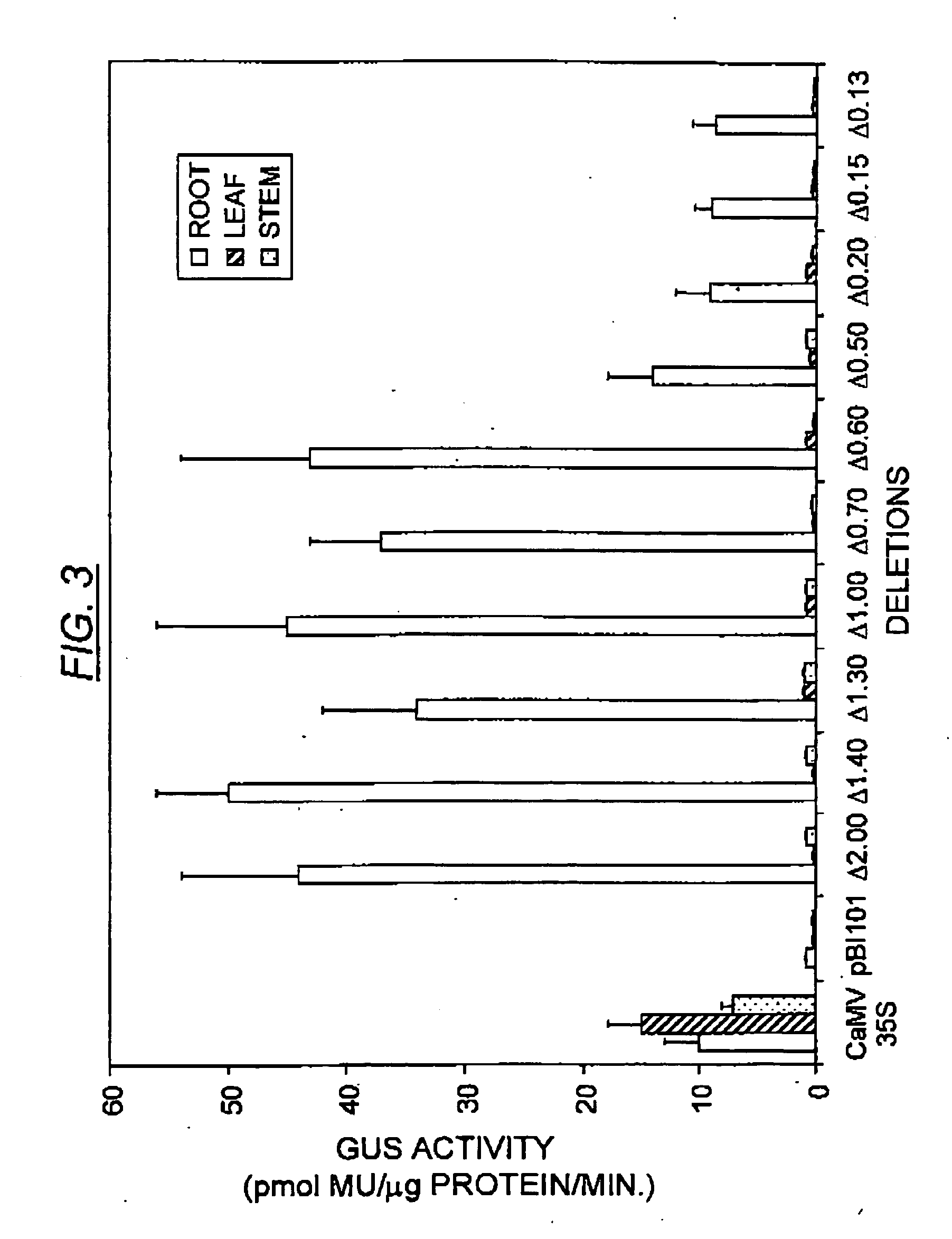Transgenic plants containing molecular decoys that alter protein content therein
a technology of molecular decoys and transgenic plants, which is applied in the direction of transferases, peptide sources, enzymology, etc., can solve the problems of reducing the abundance of that enzyme, reducing the production of end products, and increasing the end product of the biosynthetic pathway, so as to reduce the amount of tsnas and reduce the carcinogenic potential of such products
- Summary
- Abstract
- Description
- Claims
- Application Information
AI Technical Summary
Benefits of technology
Problems solved by technology
Method used
Image
Examples
example 1
Localization of Cis-Acting Element in NtOPT1 Promoter
[0073] To characterize the minimal sequence required for the NtQPT1 cis-acting element, the promoter region of the NtQPT1 gene was isolated, truncated at the 5′ end, and fused to the gene encoding β-glucuronidase (GUS) to assess function as a specific enhancer of nicotine production. The NtQPT1 gene was isolated and sequenced. The start of the transcript was determined by comparing the TobRD2 cDNA sequence to the genomic locus sequence. Sequence located 5′ of the transcription start site was defined as promoter sequence. Using PCR primers and the promoter as a template, truncations were made at the 5′ end of the promoter to determine minimal cis-acting enhancer sequence (see FIG. 2). The truncations were fused to the uidA gene, which encodes GUS. The fusion gene was inserted into a vector and transformed by standard methods of ballistic transformation into Nicotiana tabacum Burley 21.
[0074] GUS activity was assessed by dividing ...
example 2
Localization of Nic Gene Product Binding Site in NtOPT1 Promoter
[0075] The NtQPT1 promoter deletion series fused to the uidA reporter gene (encoding GUS) was transformed into nic− / nic− homozygous N. tabacum plants. R0 transformants having the transgenic DNA at a single locus were crossed with nic− / nic− or Nic+ / Nic+ homozygous plants to give homozygous (nic− / nic−) and heterozygous (Nic+ / nic−) progeny carrying the transgene (NtQPT1 promoter-GUS) at the same chromosomal location. GUS activity was quantified in multiple progeny from multiple, independent transformants and compared between Nic+ and nic− phenotypes (TABLE 1). Ratios greater than 1.5 were determined to contain the cis-acting elements responding to Nic gene product activation.
TABLE 1Regulation of NtQPT1 Promoter-Directed GUS Expression by the NicGene Products in Tobacco.Inde-pendentGUSGUSTrans-activity inactivity inGUS ratioPromoterformantsNic+ / nic−2nic− / nic−2of Nic / nic2.0 (2010)12111.7(7)21.2(5)5.346.6(6)11.9(8)5.61.3 (...
example 3
Regulation of NtOPT1 Gene Expression Using Molecular Decoys
[0077] Nucleotide sequence located between −1000 and −600 or −700 bp of the NtQPT1 promoter is inserted in tandem arrays into a plant-Agrobacterium shuttle vector and subsequently transformed into tobacco via methods known to one skilled in the art. Plants stably transformed with said vector are assessed for the level of expression of NtQPT1 and for nicotine and / or TSNA content. These experiments will demonstrate that tobacco transformed with molecular decoys that interact with Nic gene products will exhibit a reduced amount of nicotine and / or TSNA. Plants with multiple tandem insertions of the molecular decoy which have reduced NtQPT1 expression and reduced nicotine levels are used for expression of commercially valuable products and production of tobacco products having reduced nicotine and / or TSNA content.
PUM
| Property | Measurement | Unit |
|---|---|---|
| pH | aaaaa | aaaaa |
| nucleic acid construct | aaaaa | aaaaa |
| nucleic acid | aaaaa | aaaaa |
Abstract
Description
Claims
Application Information
 Login to View More
Login to View More - R&D
- Intellectual Property
- Life Sciences
- Materials
- Tech Scout
- Unparalleled Data Quality
- Higher Quality Content
- 60% Fewer Hallucinations
Browse by: Latest US Patents, China's latest patents, Technical Efficacy Thesaurus, Application Domain, Technology Topic, Popular Technical Reports.
© 2025 PatSnap. All rights reserved.Legal|Privacy policy|Modern Slavery Act Transparency Statement|Sitemap|About US| Contact US: help@patsnap.com



